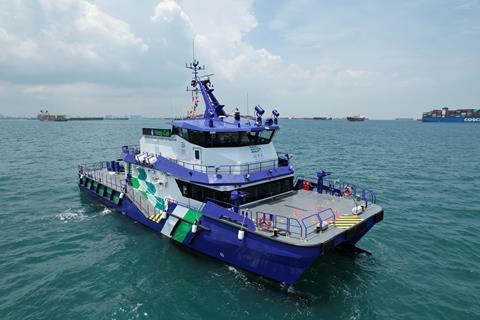A hybrid-electric vessel has been built for the Maritime and Port Authority of Singapore.
 Cleaner patrolling
Cleaner patrolling
Source: BMT
MPA Guardian will also be used as the government’s test bed for new technologies and equipment
The BMT designed vessel, developed in collaboration with Penguin Shipyard International, will conduct patrolling activities, search and rescue, oil spill response, drone operations and salvage support for the port.
“As we work towards a sustainable Maritime Singapore, reducing emissions from the domestic harbour craft fleet is an important focus area. Developing a hybrid diesel-electric vessel with electric propulsion, we made sure that our new enhanced patrol craft would be ready for a greener future,” said Ms Quah Ley Hoon, chief executive, MPA.
Test bed
The advanced 35m aluminium catamaran, christened MPA Guardian, will also be used as the government’s test bed for new technologies and equipment.
Further extending the vessel’s rescue capabilities is a 7m fast rigid-inflatable rescue boat, mated with a unique Launch And Recovery System (LARS) that was jointly developed by BMT and Penguin.
The vessel propulsion system is an advanced hybrid-electric system based on a combination of electric and diesel mechanical propulsion. To best fulfil its operating duty the vessel can operate in different modes. In full-electric, zero-emission mode, MPA Guardian can cruise silently at six knots for up to three hours.
It can also operate in a diesel-electric mode to achieve continuous medium speed operation. In this mode, power is drawn from one of the two main engines to propel both shafts while recharging the batteries. This mode offers a significant advantage by way of emissions reduction and reduced wear and tear on the engines.
In conventional diesel mechanical mode, MPA Guardian can run at a top speed of close to 27 knots. In this mode the electric generation capability offered by the hybrid system also removes the need for diesel generators sets onboard.
These features, combined with a highly efficient hull form optimised for minimal resistance across the entire operating speed range, give rise to a low-emission, future-proofed vessel that will contribute to reducing the carbon footprint of the Port of Singapore.



Comments are closed.